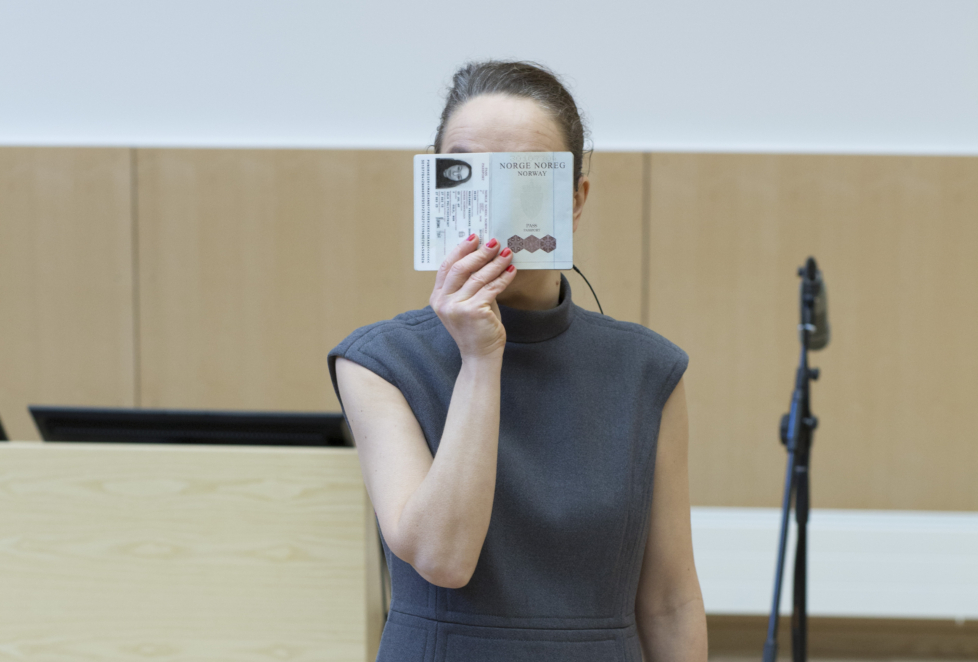
In 2019, Marianne Heier was commissioned by Public Art Norway (KORO) to create an artwork for the new building for the Faculty of Law at the University of Oslo. Titled Act, the project takes its point of departure in the United Nations Convention on Statelessness, which Norway ratified in 1956, yet still has not implemented into law. Through Act, Heier transferred the production budget allocated to her for an artwork to the organisation Norwegian Organisation for Asylum Seekers (NOAS). The first part of the work is on display inside the faculty building, in the form of a poster and a book with case notes and papers placed atop a larvikite plinth; the work also includes a speech delivered by Heier at the opening of the building in 2019.
NOAS spent the funds she made available to build legal cases for stateless persons versus the state, Heier told Kunstkritikk. “The cases are then taken through the legal system with the aim of reaching some clarification regarding Norway’s obligations under the convention. I think of Act as a conceptual sculpture. When these cases are eventually resolved and create a legal precedent, the work will be finished,” she said.
Tomorrow, Tuesday 25 April, Heier and the faculty will host a seminar on statelessness, focusing particularly on the aforementioned convention and Norway’s obligations. Heier said that the purpose of the seminar is to contribute to an understanding of the issues faced by stateless persons. According to Heier, immigration policy in Norway is hugely influenced by political agendas. At the same time, there is a major shortage of actual knowledge of the field. “Terms and concepts such as immigrant, asylum seeker, refugee, stateless, and undocumented become blurred and mixed up, making it impossible to engage in an objective, constructive debate. I hope the seminar will contribute to a more nuanced understanding of the field, and to raising awareness of the stateless peoples’ cause,” she said.

The attendees at the seminar include representatives from NOAS, the United Nations, the European Network on Statelessness, the law firm Sulland, the Ministry of Labour and Social Inclusion, and the Immigration Appeals Board (UNE). In addition, several people who are currently stateless, or who have been stateless in the past, will talk about their experiences. Heier is particularly pleased that they are involved: “These are powerful stories, involving events that are almost impossible to imagine for those of us who are lucky enough to have ‘the right to have rights’, as Hannah Arendt said.”
Heier emphasised that Act is not a relational artwork, but a project based on principles. “Stateless persons must have rights regardless of their personal characteristics or poignant experiences. They should not have any more demands placed upon them as human beings than those placed on the rest of us,” she said.
Heier said that working with NOAS and the Faculty of Law has been one of the most interesting and rewarding collaborations she has ever engaged in. The Faculty of Law embraced the project right from the start, and also uses it for teaching purposes. “Of course, we have a very clear division of responsibility,” Heier said. “I am not a lawyer and essentially have no greater insight into these issues than other lay people. But it has been very interesting to see art and law meet in this way, observing differences and similarities in how we think and examining how we can help and strengthen each other.”
The seminar will include artistic interludes by Shwan Dler Qaradaki and Victor Lind, both of whom draw on personal experiences. Dler Qaradaki will present a diary from a trip he recently made to Istanbul, where he was a stateless refugee 23 years ago. His narrative, according to Heier, refers to his own traumas, but also to wider political contexts and traditions within Islamic art.
Lind has a Jewish background, and his family escaped the persecution of Jews in Norway during the Second World War by pure chance. He will take poems by Henrik Wergeland and Paul Celan as his starting point, linking them to his own work on the accountabilities surrounding the deportation of Norwegian Jews by the collaborationist Quisling government, Heier explained. “Unfortunately, these problems are not new. They just keep happening.”









